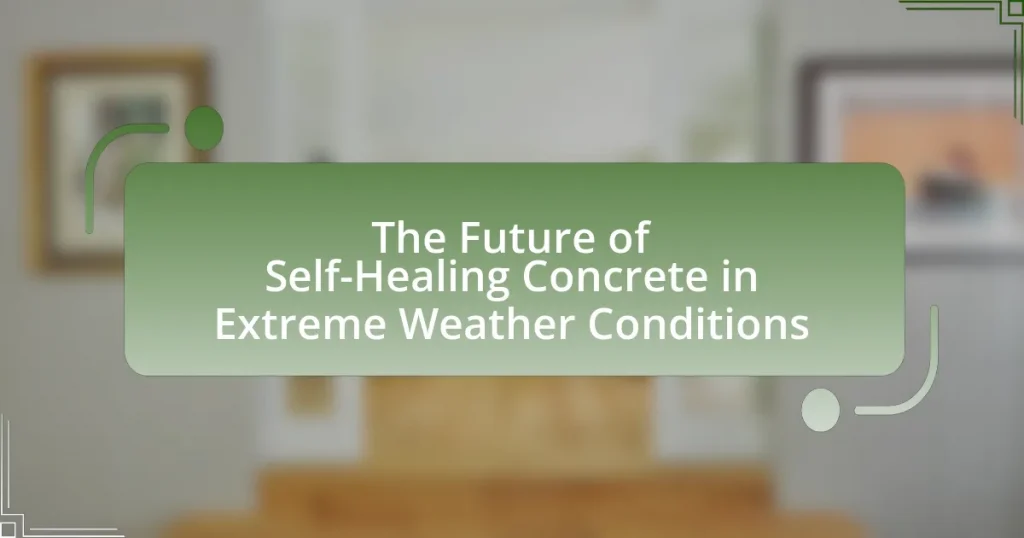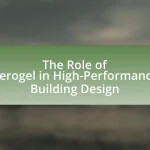Self-healing concrete is an innovative material designed to autonomously repair cracks through embedded healing agents, such as bacteria or polymers, which activate upon damage. This technology is particularly significant for structures exposed to extreme weather conditions, as it enhances durability, reduces maintenance costs, and extends the lifespan of concrete by up to 50%. The article explores the mechanisms of self-healing concrete, the materials used, its benefits in harsh environments, and the challenges it faces, including temperature fluctuations and moisture levels. Additionally, advancements in technology and best practices for implementation in construction projects are discussed, highlighting the potential of self-healing concrete to revolutionize infrastructure resilience in the face of climate change.
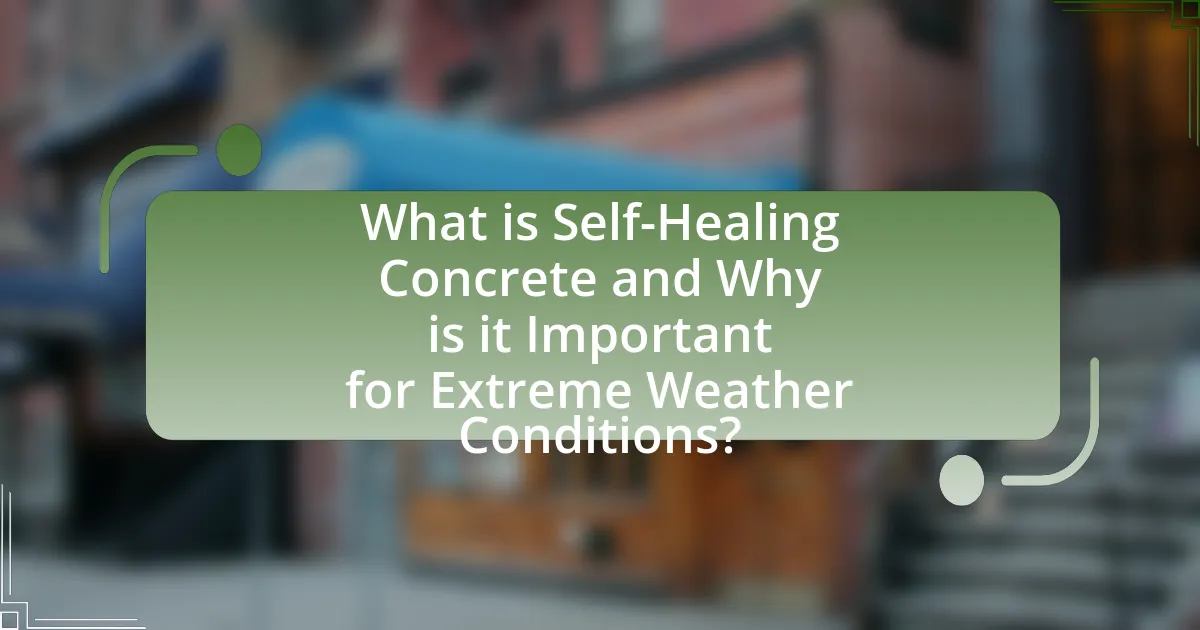
What is Self-Healing Concrete and Why is it Important for Extreme Weather Conditions?
Self-healing concrete is a type of concrete that contains self-repairing mechanisms, such as bacteria or healing agents, which activate when cracks form, allowing the material to autonomously seal itself. This property is crucial for extreme weather conditions because it enhances the durability and longevity of structures exposed to harsh environments, reducing maintenance costs and the risk of structural failure. Research indicates that self-healing concrete can significantly improve resistance to freeze-thaw cycles and water infiltration, which are common challenges in extreme weather scenarios. For instance, studies have shown that incorporating specific bacteria can lead to up to 90% crack healing efficiency, demonstrating its effectiveness in maintaining structural integrity under adverse conditions.
How does self-healing concrete function in adverse environments?
Self-healing concrete functions in adverse environments by utilizing embedded healing agents that activate upon cracking. When cracks occur, these agents, often in the form of microcapsules containing polymer or bacteria, release their contents to fill the voids and restore structural integrity. Research indicates that this mechanism can significantly enhance the durability and lifespan of concrete, particularly in extreme weather conditions, where temperature fluctuations and moisture can exacerbate damage. For instance, studies have shown that self-healing concrete can recover up to 90% of its original strength after healing, demonstrating its effectiveness in maintaining performance under challenging environmental factors.
What materials are used in self-healing concrete to enhance durability?
Self-healing concrete enhances durability through the incorporation of materials such as encapsulated healing agents, specifically bacteria, and polymer-based microcapsules. These materials facilitate the automatic repair of cracks when they occur. For instance, bacteria like Bacillus subtilis can produce calcium carbonate when activated by water, effectively sealing cracks and restoring structural integrity. Additionally, polymer microcapsules can release healing agents, such as epoxy resins, when cracks form, further contributing to the repair process. Research has shown that these materials can significantly improve the lifespan and performance of concrete structures, especially in extreme weather conditions, by reducing permeability and preventing water ingress, which can lead to deterioration.
How do these materials respond to extreme weather conditions?
Self-healing concrete materials exhibit enhanced durability and resilience in extreme weather conditions. These materials utilize encapsulated healing agents that activate upon cracking, allowing for the repair of micro-damage caused by freeze-thaw cycles, high temperatures, or heavy rainfall. Research indicates that self-healing concrete can maintain structural integrity and extend lifespan by up to 50% compared to traditional concrete, particularly in environments subject to severe weather fluctuations. This capability is supported by studies demonstrating that self-healing mechanisms significantly reduce water permeability and improve resistance to chemical attacks, which are common in harsh climates.
What are the key benefits of using self-healing concrete in extreme weather?
Self-healing concrete offers significant benefits in extreme weather conditions, primarily by enhancing durability and reducing maintenance costs. This type of concrete contains healing agents that activate when cracks form, allowing for automatic repair and preventing further damage. Research indicates that self-healing concrete can extend the lifespan of structures by up to 50%, particularly in environments subject to freeze-thaw cycles or extreme heat, where traditional concrete is prone to cracking. Additionally, the ability to self-repair minimizes the need for frequent repairs, which can be costly and disruptive, thereby providing long-term economic advantages.
How does self-healing concrete reduce maintenance costs?
Self-healing concrete reduces maintenance costs by autonomously repairing cracks and damage, which minimizes the need for manual repairs and prolongs the lifespan of structures. This innovative material contains healing agents, such as bacteria or polymer capsules, that activate upon exposure to moisture, effectively sealing cracks and preventing further deterioration. Research indicates that self-healing concrete can reduce repair costs by up to 50% over its lifespan, as demonstrated in studies conducted by the University of Cambridge, which found that structures utilizing self-healing technology require significantly less maintenance compared to traditional concrete.
What impact does self-healing concrete have on infrastructure longevity?
Self-healing concrete significantly enhances infrastructure longevity by autonomously repairing cracks and damage, thereby reducing maintenance costs and extending service life. Research indicates that self-healing mechanisms, such as encapsulated healing agents, can restore up to 95% of the original strength of concrete after damage occurs. This capability not only mitigates the effects of environmental stressors but also decreases the frequency of repairs, leading to a more sustainable infrastructure. Studies have shown that structures utilizing self-healing concrete can last up to 50% longer than traditional concrete, demonstrating its effectiveness in prolonging the lifespan of infrastructure.
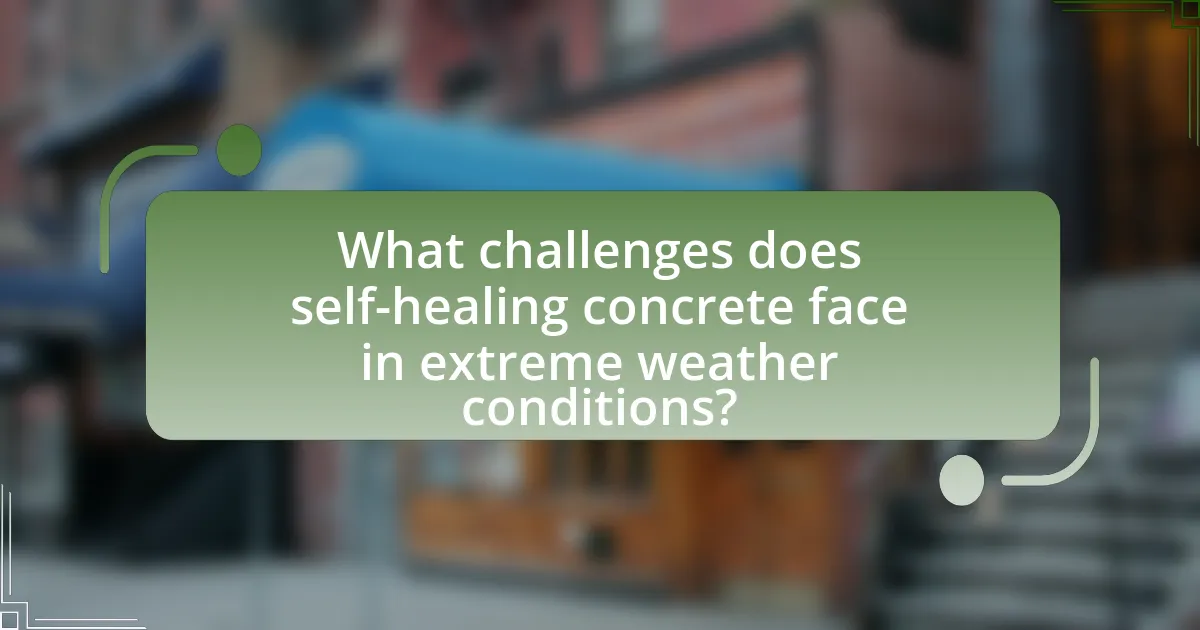
What challenges does self-healing concrete face in extreme weather conditions?
Self-healing concrete faces significant challenges in extreme weather conditions, primarily due to temperature fluctuations and moisture levels. These environmental factors can hinder the activation of self-healing mechanisms, such as the release of healing agents or the formation of calcium carbonate crystals, which are essential for repairing cracks. For instance, in freezing temperatures, the expansion of water within cracks can exacerbate damage, while high temperatures may accelerate the evaporation of moisture needed for the healing process. Additionally, extreme weather events, such as heavy rainfall or prolonged drought, can disrupt the balance of moisture required for effective healing, leading to reduced durability and performance of the concrete.
How do temperature fluctuations affect the performance of self-healing concrete?
Temperature fluctuations negatively impact the performance of self-healing concrete by affecting the activation of healing agents and the overall material properties. When temperatures drop, the viscosity of healing agents increases, which can hinder their ability to flow into cracks effectively. Conversely, high temperatures can accelerate the curing process, potentially leading to premature hardening before the healing agents can react with the concrete matrix. Research indicates that optimal temperature ranges are crucial for the effective functioning of self-healing mechanisms, as demonstrated in studies showing that healing efficiency decreases significantly outside these ranges. For instance, a study published in the journal “Construction and Building Materials” found that self-healing concrete exhibited reduced crack closure rates at temperatures below 5°C and above 35°C, highlighting the sensitivity of its performance to temperature variations.
What specific weather conditions pose the greatest risks to self-healing concrete?
Extreme weather conditions such as high temperatures, freeze-thaw cycles, and excessive moisture pose the greatest risks to self-healing concrete. High temperatures can accelerate the curing process of the healing agents, potentially leading to premature activation and reduced effectiveness. Freeze-thaw cycles can cause expansion and contraction, which may disrupt the healing process and compromise the integrity of the concrete. Excessive moisture can dilute or wash away the healing agents, preventing them from effectively sealing cracks. These factors collectively hinder the self-healing capabilities, as evidenced by studies indicating that environmental stressors significantly impact the performance of self-healing materials in concrete applications.
How can these risks be mitigated in construction practices?
Risks in construction practices can be mitigated by implementing advanced materials like self-healing concrete, which enhances durability and reduces maintenance needs. Self-healing concrete contains encapsulated healing agents that activate upon cracking, effectively sealing fissures and preventing water infiltration, which is crucial in extreme weather conditions. Research indicates that self-healing concrete can extend the lifespan of structures by up to 50%, significantly lowering the risk of structural failure due to environmental stressors. Additionally, regular training for construction workers on the use of innovative materials and adherence to safety protocols further minimizes risks associated with construction practices.
What advancements are being made to improve self-healing concrete for extreme weather?
Advancements in self-healing concrete for extreme weather include the development of bio-based healing agents and advanced polymeric materials that enhance durability and repair capabilities. Researchers are incorporating bacteria that produce calcium carbonate to fill cracks when activated by moisture, which is particularly effective in wet conditions. Additionally, the integration of superabsorbent polymers allows the concrete to retain water and facilitate healing in arid climates. Studies, such as those published in the journal “Materials,” demonstrate that these innovations significantly improve the longevity and resilience of concrete structures exposed to harsh environmental conditions.
What innovative technologies are being integrated into self-healing concrete?
Innovative technologies integrated into self-healing concrete include encapsulated healing agents, such as bacteria and polymer-based materials, which activate upon cracking. These technologies enable the concrete to autonomously repair itself, enhancing durability and longevity. For instance, research has demonstrated that bacteria like Bacillus subtilis can produce calcium carbonate to fill cracks, effectively sealing them and restoring structural integrity. Additionally, microcapsules containing healing agents can release their contents when cracks occur, further contributing to the self-healing process. These advancements are crucial for improving the performance of concrete in extreme weather conditions, where traditional materials may fail.
How are researchers addressing the limitations of current self-healing methods?
Researchers are addressing the limitations of current self-healing methods by developing advanced materials and techniques that enhance the healing efficiency and durability of self-healing concrete. For instance, the incorporation of microcapsules containing healing agents, such as epoxy resins, allows for targeted repair of cracks as they form, significantly improving the healing process. Additionally, studies have shown that using bacteria-based healing agents can promote calcite precipitation, which effectively fills cracks and restores structural integrity. Research published in the journal “Materials” by authors Zhang et al. (2021) demonstrates that these innovative approaches can lead to self-healing concrete with a healing efficiency of over 90%, thereby addressing the shortcomings of traditional methods.
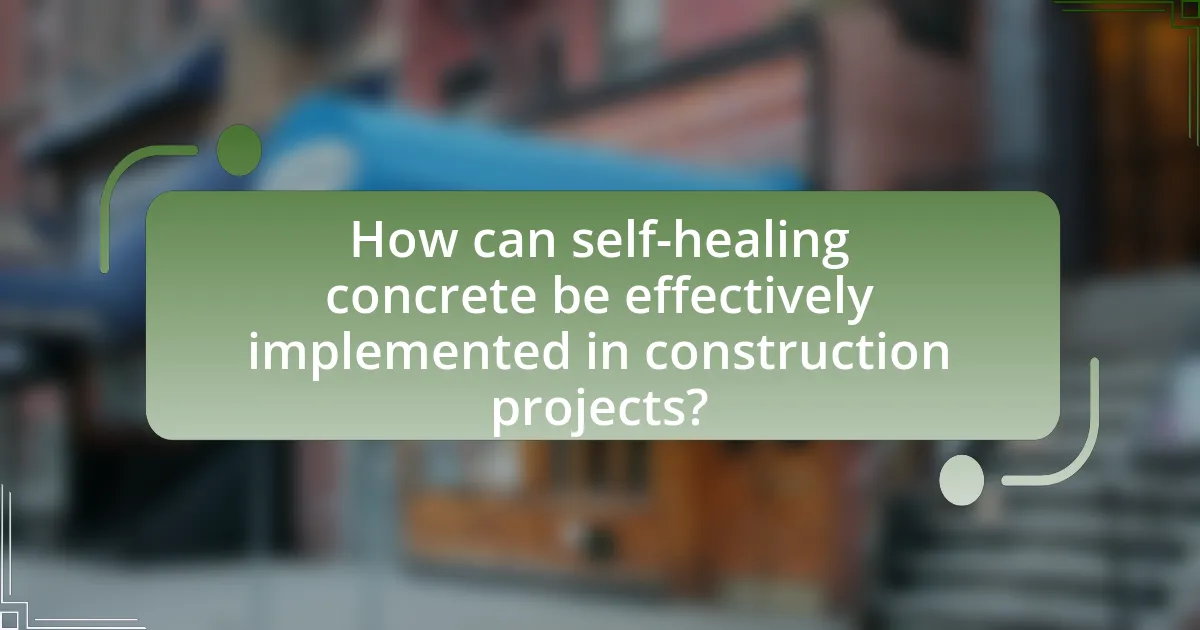
How can self-healing concrete be effectively implemented in construction projects?
Self-healing concrete can be effectively implemented in construction projects by integrating specific healing agents, such as bacteria or polymer-based materials, into the concrete mix. These agents activate upon cracking, promoting the formation of calcium carbonate or other compounds that fill the cracks and restore structural integrity. Research indicates that self-healing concrete can reduce maintenance costs by up to 50% and extend the lifespan of structures by 20% or more, as demonstrated in studies conducted by the University of Cambridge and published in the journal “Materials and Structures.” This approach not only enhances durability but also contributes to sustainability by minimizing the need for repairs and reducing material waste.
What best practices should be followed when using self-healing concrete?
When using self-healing concrete, best practices include ensuring proper mix design, selecting appropriate healing agents, and maintaining optimal curing conditions. Proper mix design is crucial as it influences the concrete’s mechanical properties and healing efficiency; for instance, incorporating specific types of bacteria or polymeric healing agents can enhance the self-healing capabilities. Selecting healing agents that are compatible with the concrete matrix and can activate under specific environmental conditions is essential for effective healing. Additionally, maintaining optimal curing conditions, such as humidity and temperature, promotes the activation of healing mechanisms, ensuring that the concrete can effectively repair itself in extreme weather conditions. These practices are supported by research indicating that the right combination of materials and environmental management significantly improves the performance and longevity of self-healing concrete.
How can contractors ensure optimal performance of self-healing concrete?
Contractors can ensure optimal performance of self-healing concrete by selecting appropriate healing agents and ensuring proper mixing and curing conditions. The use of encapsulated healing agents, such as microcapsules containing polymeric materials or bacteria, allows for effective healing of cracks when activated by moisture. Additionally, maintaining the correct water-to-cement ratio during mixing is crucial, as it influences the concrete’s overall durability and the activation of healing mechanisms. Research indicates that self-healing concrete can recover up to 90% of its original strength after crack formation, demonstrating its effectiveness when properly implemented.
What are the common pitfalls to avoid during installation?
Common pitfalls to avoid during the installation of self-healing concrete include inadequate surface preparation, improper mixing ratios, and neglecting environmental conditions. Inadequate surface preparation can lead to poor adhesion and reduced effectiveness of the self-healing agents. Improper mixing ratios can compromise the material’s performance, as the balance of components is critical for achieving the desired healing properties. Additionally, neglecting environmental conditions, such as temperature and humidity, can adversely affect the curing process, leading to suboptimal results. These factors are crucial for ensuring the longevity and functionality of self-healing concrete in extreme weather conditions.
What future trends can we expect in the development of self-healing concrete?
Future trends in the development of self-healing concrete include the integration of advanced bio-based healing agents and the use of smart materials that respond to environmental stimuli. Research indicates that incorporating bacteria or fungi can enhance the healing process by producing calcium carbonate in response to cracks, significantly improving durability. Additionally, the application of nanotechnology is expected to enable self-healing mechanisms at a molecular level, allowing for more efficient repair processes. Studies have shown that self-healing concrete can reduce maintenance costs and extend the lifespan of structures, making it a viable solution for infrastructure in extreme weather conditions.
How might climate change influence the evolution of self-healing concrete technologies?
Climate change may accelerate the development of self-healing concrete technologies due to increased frequency and severity of extreme weather events. As climate change leads to more intense storms, flooding, and temperature fluctuations, traditional concrete structures face greater risks of damage. This necessitates the adoption of advanced materials that can autonomously repair themselves, thereby enhancing durability and longevity. Research indicates that self-healing concrete can incorporate bacteria or healing agents that activate in response to cracks, which is particularly beneficial in environments subject to rapid temperature changes and moisture variations. Consequently, the demand for resilient infrastructure in the face of climate change will likely drive innovation in self-healing concrete solutions.
What role will sustainability play in the future of self-healing concrete?
Sustainability will play a crucial role in the future of self-healing concrete by reducing environmental impact and enhancing the longevity of infrastructure. The incorporation of sustainable materials, such as recycled aggregates and bio-based healing agents, will minimize resource depletion and carbon emissions associated with traditional concrete production. Research indicates that self-healing concrete can significantly extend the lifespan of structures, thereby reducing the need for repairs and replacements, which contributes to lower overall environmental costs. For instance, a study published in the journal “Materials” highlights that self-healing concrete can reduce maintenance costs by up to 50%, demonstrating its potential for sustainable construction practices.
What practical tips can be applied when considering self-healing concrete for projects?
When considering self-healing concrete for projects, it is essential to evaluate the specific healing mechanisms available, such as encapsulated healing agents or bacteria-based systems. These mechanisms can significantly enhance the durability and longevity of concrete structures, particularly in extreme weather conditions. For instance, research indicates that bacteria-based self-healing concrete can repair cracks up to 0.5 mm wide, effectively preventing water ingress and subsequent damage. Additionally, selecting the appropriate mix design that incorporates these self-healing agents is crucial, as it influences the material’s performance and healing efficiency. Implementing rigorous testing protocols to assess the effectiveness of the self-healing properties under simulated environmental stresses can further ensure the reliability of the concrete in real-world applications.
